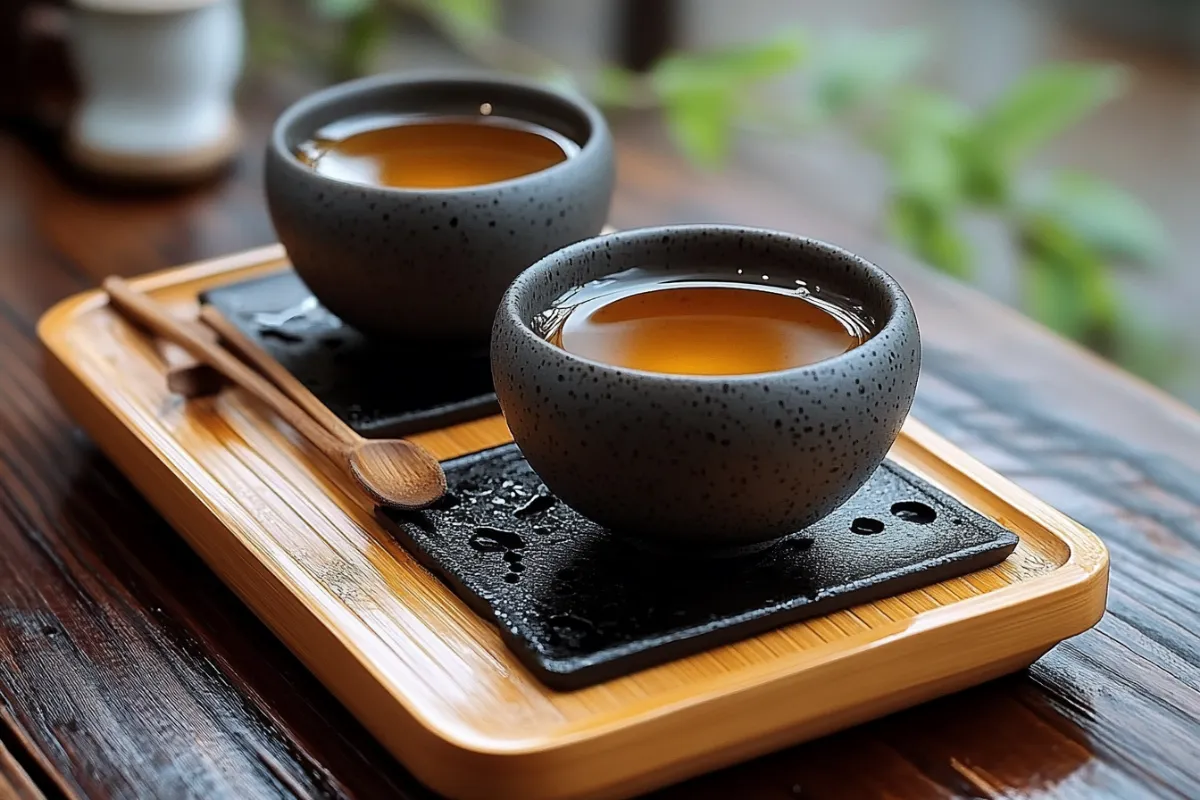Chinese Restaurant Tea: What Tea Do They Actually Serve?
When you step into a Chinese restaurant, one of the first things you’re likely served is a steaming pot of tea. This aWhen you step into a Chinese restaurant, you’re often welcomed with a steaming pot of tea. This aromatic beverage offers more than simple refreshment—it delivers a cultural experience that enhances every meal. In fact, serving tea represents hospitality, respect, and a warm invitation to guests. But have you ever wondered, what tea do Chinese restaurants actually use?
In this article, you’ll discover:
- The most popular teas served in Chinese restaurants, from floral jasmine to earthy pu-erh
- The health benefits associated with these traditional teas
- How to perfectly pair tea with Chinese dishes
- A simple recipe to brew authentic Chinese restaurant tea at home
- Answers to the most common questions about Chinese restaurant tea
Let’s dive into the rich world of Chinese tea and explore why it remains an essential part of dining traditions.
The Role of Tea in Chinese Culture
Tea has held a vital place in Chinese culture for thousands of years. According to legend, Emperor Shen Nong discovered tea by accident when tea leaves drifted into his pot of boiling water. Since then, tea has symbolized hospitality, respect, and tradition in Chinese society.
In Chinese restaurants, serving tea immediately sets the tone for the dining experience, creating an atmosphere of warmth and connection. Therefore, ancient customs rooted in goodwill and honor continue to influence this practice today.
To truly understand the tea served in Chinese restaurants, you must look deeper into its cultural roots and the varieties that have become culinary staples. From the fragrant notes of jasmine tea to the earthy richness of pu-erh, each type of tea carries a unique history, flavor profile, and cultural significance.
Whether shared during a casual meal or a grand celebration, tea reflects centuries of tradition and the art of balancing flavors.
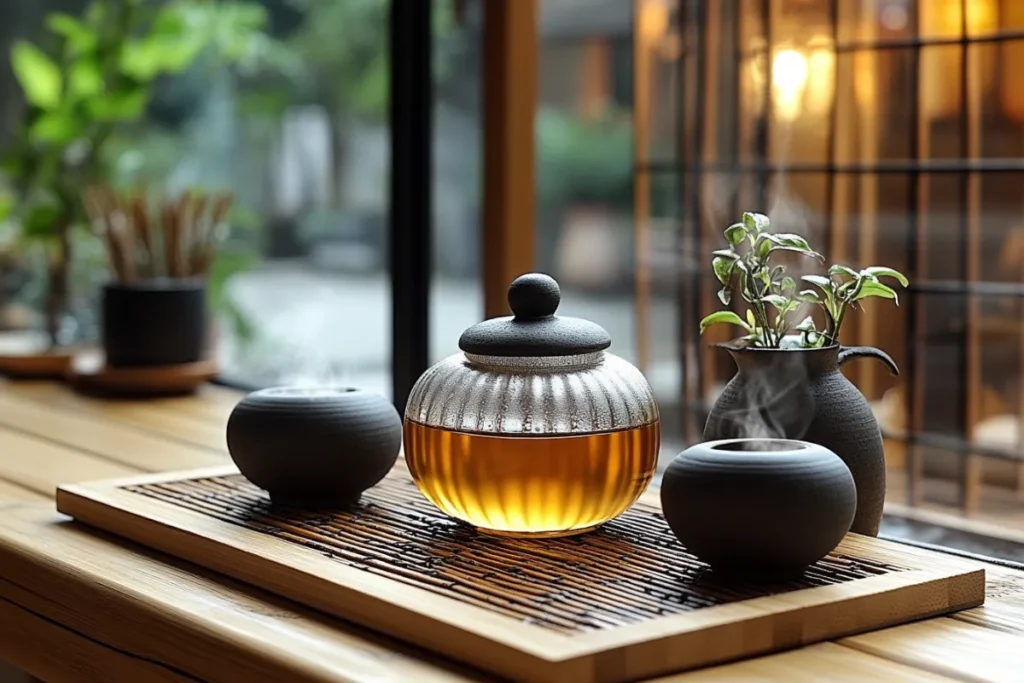
he Role of Tea in Traditional Chinese Celebrations
Tea also plays an essential role in many Chinese celebrations, from weddings to festivals. During weddings, couples participate in a tea ceremony known as jing cha, where they serve tea to their elders to show respect and gratitude. This heartfelt ritual strengthens family bonds and honors ancestors.
Moreover, during festivals such as the Lunar New Year and the Mid-Autumn Festival, families gather to share tea, fostering unity and harmony. For instance, many people enjoy chrysanthemum tea during the Double Ninth Festival because of its cooling properties and symbolic association with longevity.
Thus, when you enjoy tea in a Chinese restaurant, you participate in these rich traditions—experiencing centuries of cultural significance through every cup.
The Most Popular Teas Served in Chinese Restaurants
Chinese restaurants often serve a handful of classic teas selected for their ability to complement the flavors of Chinese cuisine. Let’s explore the most popular options:
1. Jasmine Tea: The Fragrant Favorite
Jasmine tea remains one of the most beloved choices in Chinese restaurants. Crafted by blending green tea leaves with jasmine blossoms, it offers a delicate floral aroma and a light, refreshing taste.
Why It’s Popular: Jasmine tea acts as a perfect palate cleanser, balancing the bold flavors of savory or spicy dishes.
Health Benefits: Packed with antioxidants, jasmine tea helps boost digestion, strengthens the immune system, and promotes relaxation.
Furthermore, its calming scent creates a peaceful dining environment, enhancing the overall experience.
2. Oolong Tea: A Balanced Classic
Oolong tea, which undergoes partial oxidation, bridges the flavor gap between green and black teas. Depending on its oxidation level, oolong can taste floral, fruity, toasty, or robust.
Why It’s Popular: Oolong’s versatility allows it to pair well with both light seafood dishes and hearty roasted meats.
Health Benefits: Studies associate oolong tea with improved metabolism, better heart health, and support for weight management.
Additionally, oolong’s moderate caffeine content provides a gentle energy boost without the jitters associated with coffee.
3. Pu-erh Tea: The Earthy Digestive Aid
Pu-erh tea undergoes fermentation and aging, developing a rich, earthy flavor profile over time. Its deep taste distinguishes it from other teas.
Why It’s Popular: Pu-erh’s bold flavor cuts through rich, oily foods, making it a favorite accompaniment at dim sum and banquets featuring dishes like Peking duck.
Health Benefits: Pu-erh supports digestion and helps lower cholesterol levels, making it a natural choice after hearty meals.
As a result, many diners appreciate its ability to balance heavy dishes and cleanse the palate.
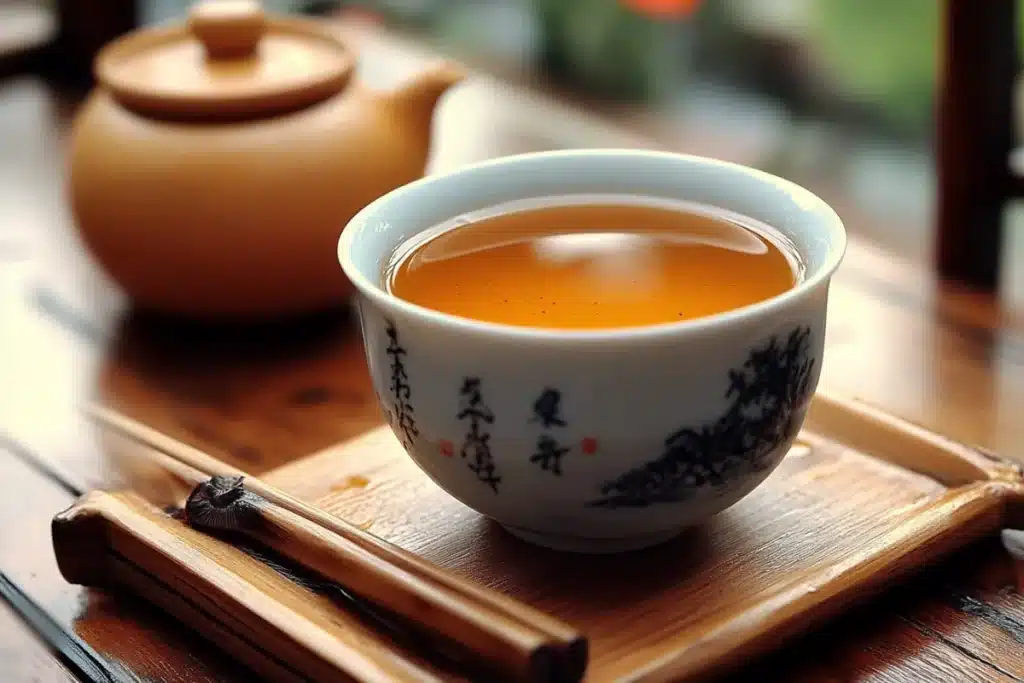
The Difference Between Chinese Restaurant Tea and Western Tea
Although Chinese and Western teas both come from the Camellia sinensis plant, their preparation, flavor, and cultural meanings differ dramatically.
Preparation: Chinese teas usually feature loose-leaf blends infused with flowers or herbs, such as jasmine or chrysanthemum. Diners enjoy them plain, without milk or sugar, to preserve their natural flavors. In contrast, Western teas, especially black tea, often include milk, sugar, or lemon. Additionally, modern Western culture has popularized creative tea-based beverages, such as the Green Tea Shot and the Refreshing White Tea Shot, which combine tea flavors with vibrant, fun twists.
Flavor: Chinese teas typically showcase delicate, layered flavors, while Western teas tend toward bold, straightforward profiles.
Cultural Significance: Tea in China carries deep ties to tradition, ceremonies, and hospitality. Meanwhile, in the West, tea usually serves as a casual beverage enjoyed socially or for relaxation.
Thus, when you sip tea in a Chinese restaurant, you’re experiencing much more than just a beverage—you’re tasting a slice of cultural history.
How to Brew Authentic Chinese Restaurant Tea at Home
Want to capture the flavor of Chinese restaurant tea in your own kitchen? Follow this simple recipe for authentic jasmine tea:
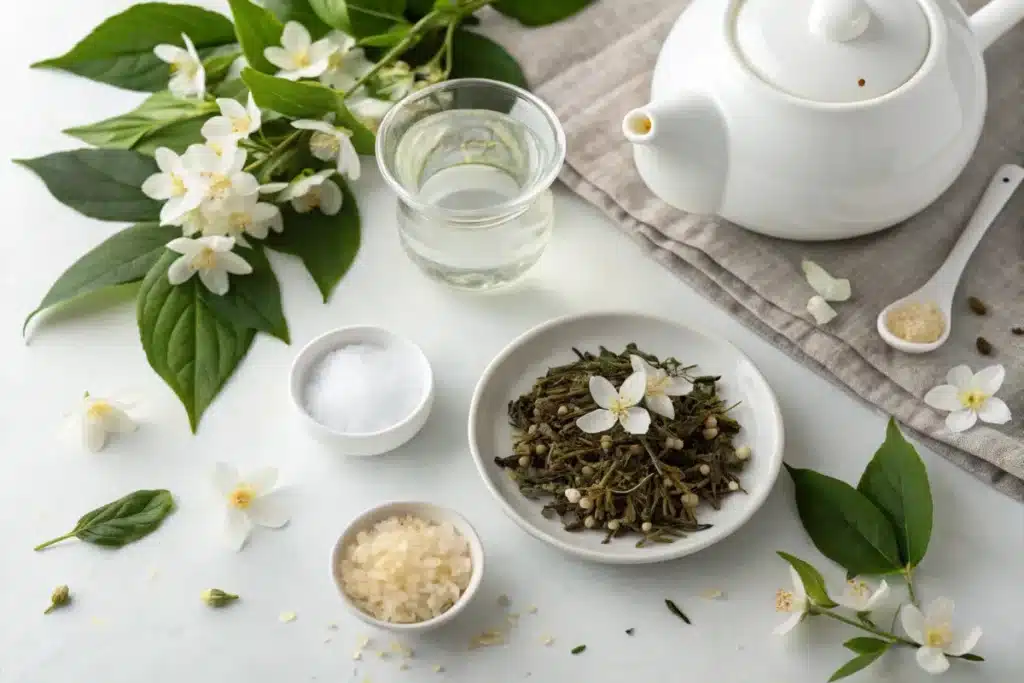
JasJasmine Tea Recipe
Ingredients:
- 1 tablespoon loose-leaf jasmine tea
- 2 cups water (heated to 175°F or 80°C)
- Optional: rock sugar or honey for sweetening
Instructions:
- Heat the water to 175°F (80°C). Avoid boiling it, as high temperatures can scorch delicate tea leaves.
- Place jasmine tea leaves in a teapot or infuser.
- Pour hot water over the tea leaves and steep for 2–3 minutes.
- Strain the tea into cups.
- Add sweetener if desired, then enjoy the aromatic, soothing flavors of authentic jasmine tea.
For the best results, use freshly filtered water and a glass or porcelain teapot.
The Health Benefits of Chinese Restaurant Tea
The teas traditionally served in Chinese restaurants offer a wide range of health benefits beyond their pleasing flavors:
1. Rich in Antioxidants
Green tea, jasmine tea, and oolong tea brim with antioxidants that help fight free radicals and reduce inflammation.
Consequently, regular tea drinkers often experience better immune health and a reduced risk of chronic diseases.
2. Supports Digestion
Teas like pu-erh and oolong actively aid digestion, especially after heavy or greasy meals.
Therefore, enjoying tea with your meal can significantly improve digestive comfort.
3. Reduces Stress
Herbal options such as chrysanthemum tea and fragrant jasmine tea promote relaxation and help manage stress levels naturally.
Thus, a soothing cup of tea can be an easy way to unwind after a long day.
4. Assists with Weight Management
Both oolong and green teas boost metabolism and support healthy weight loss efforts, according to several studies.
As a result, tea lovers may find it easier to maintain a healthy body weight.
If you’re interested in exploring other health-focused beverages, you might also enjoy this lemon balm drink for weight loss, which offers its own unique benefits.
Tea Pairings: How to Match Tea with Chinese Dishes
Pairing the right tea with your meal can elevate your dining experience. Here are classic pairings to try:
- Jasmine Tea: Ideal with spicy Szechuan dishes or delicate dim sum platters.
- Oolong Tea: Complements roasted meats, stir-fries, and seafood beautifully.
- Pu-erh Tea: Balances rich, fatty dishes like crispy pork belly or Peking duck.
- Chrysanthemum Tea: Matches well with steamed dumplings and lighter vegetable dishes.
- Green Tea: Versatile enough to accompany almost any Chinese dish.
In short, selecting the right tea brings out the best in both the food and the drink.
Frequently Asked Questions About Chinese Restaurant Tea
1. Is the tea in Chinese restaurants free?
Most Chinese restaurants offer complimentary tea as a gesture of hospitality. However, some upscale or specialty restaurants might charge for premium or rare tea selections.
2. Can I request a specific type of tea?
Yes, you can usually request a specific tea like jasmine, oolong, or pu-erh. In fact, servers are often happy to recommend a tea pairing based on your meal choice.
3. What’s the best tea to pair with spicy food?
Jasmine tea and chrysanthemum tea pair especially well with spicy foods, offering a cooling effect that balances the heat.
4. Does Chinese restaurant tea contain caffeine?
Most traditional Chinese teas do contain caffeine. Green and oolong teas have moderate levels, while pu-erh carries slightly more. If you prefer caffeine-free options, herbal teas like chrysanthemum provide a great alternative.
5. What is the most popular tea served in Chinese restaurants?
Jasmine tea tops the list. Its fragrant aroma, mild flavor, and versatility with different dishes make it a favorite among diners.
6. Can I buy the same tea served in restaurants?
Absolutely! Many Asian grocery stores and online retailers carry high-quality loose-leaf jasmine, oolong, and pu-erh teas, allowing you to recreate the restaurant experience at home.
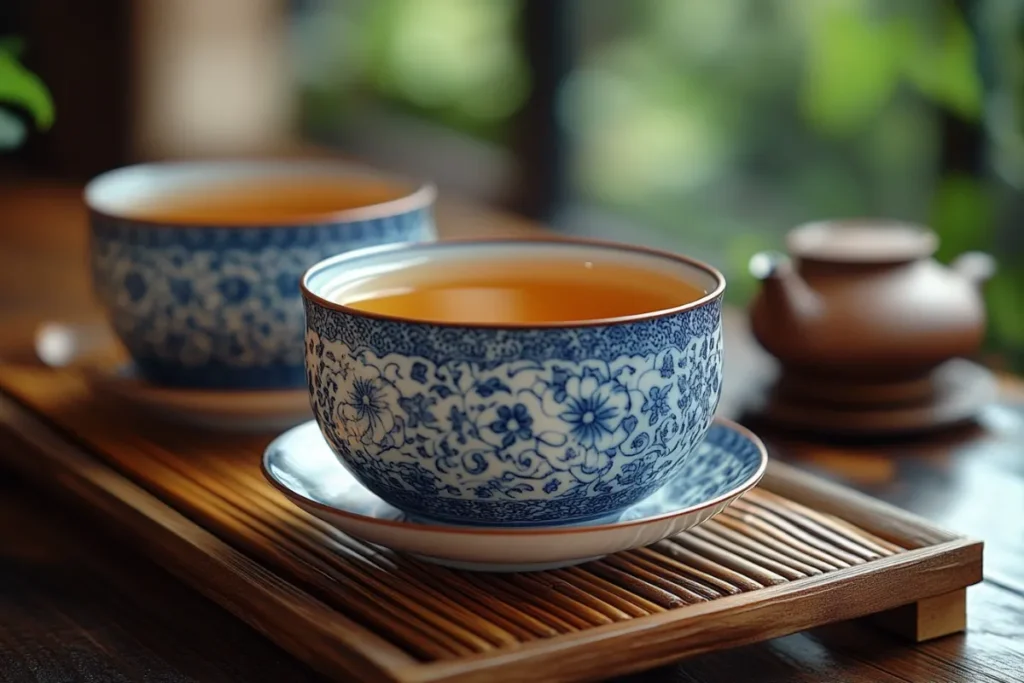
Conclusion: The Timeless Appeal of Chinese Restaurant Tea
So, what is the tea used in Chinese restaurants? From the fragrant jasmine tea to the robust pu-erh, these teas are more than just beverages—they’re an integral part of the dining experience. Whether you’re enjoying a casual meal or a festive banquet, the tea served in Chinese restaurants reflects centuries of tradition, culture, and hospitality. According to Harvard’s Nutrition Source, tea is rich in antioxidants and has been linked to improved heart health, better digestion, and reduced stress. To learn more about the science-backed benefits of tea, check out this comprehensive guide on tea and health.
Tea enhances every meal, telling a story of connection and respect while delivering proven health benefits. According to Harvard’s Nutrition Source, tea consumption links to improved heart health, better digestion, and reduced stress.
Therefore, next time you enjoy a pot of tea at a Chinese restaurant, savor not just the taste but also the rich tradition behind every sip. And if you’re inspired to bring that experience home, brewing your own authentic Chinese tea is simple and rewarding.
Have you brewed Chinese restaurant tea at home? Share your experience in the comments below!
Print
Jasmine Tea Recipe
- Total Time: 5 minutes
- Yield: 2 cups (1–2 servings) 1x
- Diet: Vegan
Description
This aromatic jasmine tea recipe highlights the delicate floral notes of jasmine blossoms, creating a soothing and refreshing beverage. Perfect for tea lovers, this method ensures a perfectly balanced cup every time, whether you’re using loose-leaf tea or tea bags.
Ingredients
- 2 teaspoons loose-leaf jasmine tea (or 2 jasmine tea bags)
- 2 cups water (filtered, if possible)
- 1–2 teaspoons honey or sugar (optional, for sweetness)
- 1–2 fresh jasmine flowers (optional, for garnish)
- 1 slice of lemon (optional, for a citrus twist)
Instructions
- Heat the Water:
- Bring the water to a gentle boil (about 175°F–185°F or 80°C–85°C). Avoid boiling the water too vigorously, as it can scorch the delicate tea leaves.
- Steep the Tea:
- Place the loose-leaf jasmine tea or tea bags in a teapot or heatproof mug.
- Pour the hot water over the tea and let it steep for 2–3 minutes. For a stronger flavor, steep for up to 4 minutes, but avoid over-steeping to prevent bitterness.
- Sweeten (Optional):
- If desired, add honey or sugar to taste and stir until dissolved.
- Garnish & Serve:
- Pour the tea into cups and garnish with fresh jasmine flowers or a slice of lemon for an extra touch of elegance.
- Enjoy:
- Sip slowly and savor the calming floral aroma and flavor.
- Prep Time: 2 minutes
- Cook Time: 3 minutes (steeping time)
- Category: Drinks
- Method: Steeping
- Cuisine: Chinese
Nutrition
- Serving Size: 1 cup (8 oz)
- Calories: 2 kcal (without sweetener)
- Sugar: 0 g (without sweetener)
- Sodium: 0 mg
- Fat: 0 g
- Saturated Fat: 0 g
- Unsaturated Fat: 0 g
- Trans Fat: 0 g
- Carbohydrates: 0 g
- Fiber: 0 g
- Protein: 0 g
- Cholesterol: 0 mg

